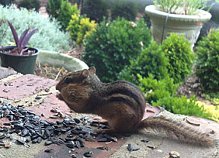 Chipmunks can be an amusing asset to a garden. Their small size, attractive coloration and frenetic search for food make them very entertaining as they dash around stopping only to sit up on their hind legs to look around or fill their checks with seeds. Unfortunately, chipmunks as cute as they are, can cause damage to home and garden. They tend to be more of a nuisance, however, than a serious threat.
Chipmunks can be an amusing asset to a garden. Their small size, attractive coloration and frenetic search for food make them very entertaining as they dash around stopping only to sit up on their hind legs to look around or fill their checks with seeds. Unfortunately, chipmunks as cute as they are, can cause damage to home and garden. They tend to be more of a nuisance, however, than a serious threat.
Chipmunks cause problems for people when they burrow under porches, concrete slabs, stairs, and foundations. They may also damage plants roots as they excavate their borrows and munch on shallowly planted bulbs such as crocuses. Chipmunks are omnivores and eat nuts, seeds, berries, plants shoots, fungi, insects, earthworms, mice, frogs, salamanders, bird eggs and nestlings and often come to bird feeders for the seeds. Chipmunks predators include hawks, owls, red fox, raccoons, weasels, coyotes, snakes and house cats.
A two inch wide hole in the ground that goes straight down indicates the presence of a chipmunk burrow. Chipmunks make their nests in the borrows and may have special areas for food storage and waste disposal. Chipmunks in cold climates hibernate but wake from their stupor regularly to eat. Chipmunks in warm climates may estivate during hot periods. Depending on the climate, chipmunks mate once or twice a year producing two to eight young with a gestation period of about 31 days. Weaning takes place at four to six weeks and the young leave the nest in the following two weeks.
The most common chipmunk is the Eastern chipmunk, Tamias striatus, the only one in the East but there are twenty one different species of chipmunk in the West. The Eastern chipmunk is the largest, with an average head and body length of 5-6 inches and weighing 3½ ounces. The smallest is the least chipmunk, measuring four inches and weighing 1¼ ounces. Chipmunks are gray to light brown and orange- with alternating stripes on their backs.
Options for control depend on the problem the chipmunks are causing. The use of squirrel baffles or feeding birds only in the winter months when the chipmunks are hibernating will decrease the raiding of bird feeders. Using ¼” mesh as a fence or 1” mesh to cover the ground will protect small bulbs but may impede the emergence of large bulbs like tulips and hyacinths. Quarter inch mesh can be used to prevent tunneling by sinking it a foot below ground level. Alternatively, plant bulbs like Narcissus that contain a chemical that deter chipmunks as well as many other mammals. Trapping is a possibility but check with local authorities to find acceptable sites for relocation.
